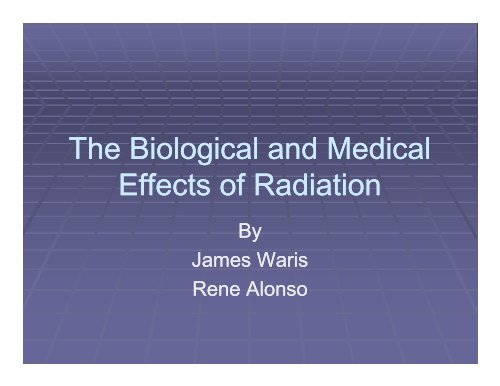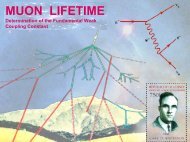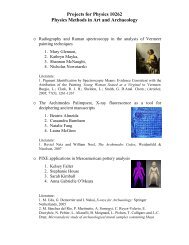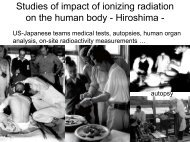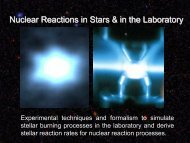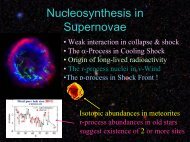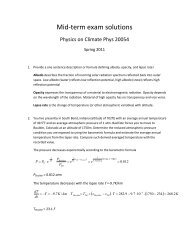The Biological and Medical Effects of Radiation
The Biological and Medical Effects of Radiation
The Biological and Medical Effects of Radiation
You also want an ePaper? Increase the reach of your titles
YUMPU automatically turns print PDFs into web optimized ePapers that Google loves.
<strong>The</strong> <strong>Biological</strong> <strong>and</strong> <strong>Medical</strong><br />
<strong>Effects</strong> <strong>of</strong> <strong>Radiation</strong><br />
By<br />
James Waris<br />
Rene Alonso
Atomic Bomb in Hiroshima<br />
• Video
Types <strong>of</strong> <strong>Radiation</strong><br />
• <strong>The</strong>re are many types <strong>of</strong> radiation.<br />
• Different wavelengths across electromagnetic<br />
spectrum<br />
• <strong>The</strong>rmal, residual, ionizing<br />
• Ionizing radiation is what is dangerous to living<br />
cells.<br />
http://www.dnr.sc<br />
.gov/ael/personal<br />
s/pjpb/lecture/sp<br />
ectrum.gif
What is Ionizing <strong>Radiation</strong>?<br />
• High energy radiation<br />
• Can penetrate matter<br />
• Ejects electrons from atomic orbits<br />
http://www.eeae.gr/en/pics/president/_eeae_02.jpg
Types <strong>of</strong> Ionizing <strong>Radiation</strong><br />
• Gamma Rays<br />
• X-Rays<br />
• Alpha Particles<br />
• Beta Particles<br />
• Neutrons<br />
http://www.stollereser.com/images/radiation_pentr<br />
ation.gif<br />
http://www.youtube.com/wat<br />
ch?v=K_zc1WKT0CA<br />
http://www.radiationcontrol.utah.gov/images/EMF3SPEC.GIF
<strong>Effects</strong> <strong>of</strong> <strong>Radiation</strong> on Cells<br />
• Living tissues are injured due to the<br />
transfer <strong>of</strong> energy to the molecules in the<br />
cellular structure.<br />
• <strong>The</strong>se molecules become excited <strong>and</strong> the<br />
following can result:<br />
• Production <strong>of</strong> free radicals<br />
• Breakage <strong>of</strong> chemical bonds<br />
• Damage to molecules that regulate<br />
essential processes (ie. DNA <strong>and</strong> RNA)
<strong>Effects</strong> <strong>of</strong> Ionizing <strong>Radiation</strong><br />
http://www.youtube.co<br />
m/watch?v=uN82GLQ<br />
YAUQ<br />
http://www.windows.ucar.edu/earth/Lif<br />
e/images/radiation_dna_damage_<br />
big.jpg<br />
http://www.radiation-scott.org/radsource/4341-3.gif
<strong>Effects</strong> on Different tissues<br />
• Cells with a high rate <strong>of</strong><br />
division are most<br />
vulnerable to damage by<br />
radiation<br />
• Blood-forming organs <strong>and</strong><br />
reproductive organs are<br />
most vulnerable.<br />
• Skin, bone <strong>and</strong> teeth, <strong>and</strong><br />
muscle intermediate<br />
• Nervous system is the<br />
least vulnerable<br />
• Developing embryos most<br />
sensitive<br />
http://pub.ucsf.edu/magazine/200305/images/bonemarrow.jpg<br />
http://emptysuit.files.wordpress.com/2009/03/embryo7.jpg<br />
http://www.mesoblast.com/images/images-mesoblast_cell_division_still.jpg
Background <strong>Radiation</strong><br />
We are constantly surrounded <strong>and</strong> exposed to low<br />
levels <strong>of</strong> radiation on a daily basis. In the US, we<br />
receive a dose <strong>of</strong> around 100 mrem <strong>of</strong> radiation from<br />
the environment each year. (Although this can very<br />
greatly depending on where you live.) This comes from<br />
a variety <strong>of</strong> sources:<br />
•Cosmic Rays from Space<br />
~44mrem<br />
•Gamma radiation from external<br />
radioactivity ~40 mrem<br />
•Internal radiation ~18 mrem
<strong>Medical</strong> <strong>Radiation</strong><br />
• In addition to the radiation we receive from<br />
the environment, we also receive an<br />
annual dose <strong>of</strong> around 50 mrem from<br />
medical sources.<br />
• This includes techniques such as x-rays<br />
http://midgetwrangler.files.wordpress.com/2008/11/ct-scan.jpg<br />
http://www.pulsetoday.co.uk/Pictures/web/w/d/h/Coloured_CT_scan_<br />
http://www.signingtime.com/rachel/wpcontent/uploads/2007/07/rachels-arm-x-ray-720x480.jpg<br />
<strong>of</strong>_the_brain_in_head_side_view___SPL___single_use_only.jpg
Danger <strong>of</strong> Low Dose <strong>Radiation</strong><br />
• Low dose radiation sustained over a long<br />
period <strong>of</strong> time may increase risk <strong>of</strong> cancer.<br />
• Difficult to determine effects, because<br />
levels l so similar il to background levels.<br />
l<br />
• If risks exist they are minimal<br />
http://www.eurekalert.org/multimedia/pub/web/2413_web.jpg<br />
http://z.about.com/d/chemistry/1/0/A/o/glowinthedarktesttube
Putting Danger into Perspective<br />
• <strong>The</strong> following all have a<br />
one in a million chance <strong>of</strong><br />
death.<br />
• Exposure to 10 mrem<br />
dose <strong>of</strong> radiation<br />
• Smoking 1.4 cigarettes in<br />
a lifetime (lung cancer)<br />
• Spending two days in New<br />
York City (air pollution)<br />
• Driving 40 miles in a car<br />
(accident)<br />
http://www.pollutionissues.com/images/paz_01_img0020.jpg<br />
http://www.anna.aero/wp-content/uploads/2008/03/nwa-plane-clouds.jpg
Putting Risk into Perspective<br />
• A 1991 NRC draft guide attempted to place an estimate<br />
on the loss <strong>of</strong> life expectancy from exposure to 300mrem<br />
<strong>of</strong> radiation (average occupational exposure).<br />
• Dose <strong>of</strong> 300 mrem/year – 15 days<br />
• Smoking 20 cigarettes a day – 6 years<br />
• Overweight by 15% - 2 years<br />
• All accidents – 207 days<br />
• Alcohol (US average) – 1 year<br />
http://topekansforjustice.files.wordpress.com/2009/06/clock_ticking.jpg<br />
http://blogs.e-rockford.com/comings<strong>and</strong>goings/files/2009/06/whiskey.jpeg
High Dose Exposure<br />
• Acute Whole-body exposure to high doses<br />
<strong>of</strong> radiation results in irreversible damage<br />
to cells. <strong>The</strong> exact consequences depend<br />
on the amount <strong>and</strong> length <strong>of</strong> exposure.<br />
http://www.mjstrauss.com/wp-content/uploads/2009/05/atomic_bomb_explosion_2-copy.jpg<br />
http://blog.tmcnet.com/blog/tom-keating/images/radioactive-homer-simpson.jpg8
Acute <strong>Effects</strong> <strong>of</strong> Whole Body<br />
Exposure<br />
Dose<br />
(Rem)<br />
5-20<br />
Effect<br />
20 Possible Chromosome damage<br />
Goldman, 1982<br />
20-100<br />
100 Temporary Reduction in Leukocytes<br />
>50 = temporary sterility in men<br />
100- Mild <strong>Radiation</strong> sickness (vomiting, diarrhea,<br />
200 fatigue, reduced d immune)<br />
200- Serious <strong>Radiation</strong> sickness (above plus bone<br />
300 marrow sickness <strong>and</strong> hemorrhage h LD 10-35/30)
Dose<br />
(Rem)<br />
300-400<br />
400<br />
1000<br />
Acute <strong>Effects</strong> <strong>of</strong> Whole Body<br />
Exposure<br />
Effect<br />
400 Serious <strong>Radiation</strong> Sickness plus bone-marrow <strong>and</strong><br />
intestine destruction. Sterility in women.<br />
LD 50-70/30<br />
400- Acute illness, early death; LD 60-95/30<br />
1000<br />
5000<br />
>5000<br />
1000- Acute illness, death in days. LD 100/10<br />
>5000 Acute illness, death in hours-days; central nervous<br />
syndrome. LD 100/2<br />
Goldman, 1982
Lethal Doses<br />
• Mammals LD 50 =350-800 rem<br />
• Bacteria LD 50 ~5000 rem<br />
• Lethal dose for insects shows a lot <strong>of</strong><br />
variability. As high as 100-500 kilorems<br />
for some species.<br />
• Plants: LD 50 is in the kilorads<br />
http://www.ecoliblog.com/GP2144.jpg
Atomic Blast<br />
(Hiroshima/Nagasaki)<br />
• Types <strong>of</strong> Radioactive<br />
Exposure:<br />
• <strong>The</strong>rmal Burns (infrared<br />
heat radiation)<br />
• Beta Burns (ionizing<br />
radiation on fallout<br />
particles)<br />
• Gamma Burns (highly<br />
penetrating)
Different Stages<br />
– Initial Stage<br />
• First 1-2 weeks.<br />
• Greatest number <strong>of</strong> deaths.<br />
• 90% due to thermal burns/ blast effects<br />
• 10% due to superlethal radiation exposure<br />
• Blast <strong>Effects</strong>- pressure over .8 bar<br />
destroys most buildings.<br />
http://img154.imageshack.us/img154/8805/radiation01ue5.jpg
Different Stages<br />
– Intermediate<br />
• Deaths occurring after 3-8 weeks<br />
• Deaths due to ionizing radiation in median<br />
lethal range<br />
http://www.gensuikin.org/panel/16-1.jpg<br />
http://i.bnet.com/blogs/19123main_fireradsafety5_sm.jpg
Different stages - Late<br />
• Period 8-20 weeks after blast<br />
• Characterized by improvement in survivors<br />
conditions
Different Stages - Delayed<br />
• 20+ weeks after blast.<br />
• Complications from wounds<br />
• Infertility<br />
• Blood Disorders<br />
• Genetic effects<br />
• Birth Defects<br />
• Cancer<br />
• Cataracts<br />
t<br />
http://bryanking.net/wp-content/uploads/2008/08/blood_disorder.jpg<br />
p p
Levels at Hiroshima/Nagasaki<br />
1 Sievert =<br />
100 Rem
A-bomb Survivors<br />
• Almost half <strong>of</strong> all leukemia cases in A-<br />
bomb survivors were attributable to<br />
radiation from the blast.<br />
• As <strong>of</strong> 1990, 4,565 solid cancer deaths.<br />
8% attributable to radiation.<br />
• As much as 70% <strong>of</strong> cancers from A-bomb<br />
radiation are expected to appear in the<br />
next 20 years.
Famous Survivors<br />
• Sadako Sasaki<br />
• 2 years old in 1945<br />
• Exposed to Hiroshima<br />
<strong>Radiation</strong><br />
• 1954- red/purple spots<br />
appear (symptoms <strong>of</strong><br />
Leukemia)<br />
• 1000 paper cranes<br />
• Dies 1955<br />
http://upload.wikimedia.org/wikipedia/commons/thumb/3/3e/Sadako_Sasaki_2008_01.JPG/450px-Sadako_Sasaki_2008_01.JPG
Chernobyl – 1986 Ukraine<br />
• Plutonium, noble<br />
gases, <strong>and</strong> fission<br />
products released into<br />
environment<br />
• Iodine <strong>and</strong> strontium<br />
most dangerous (food<br />
chain)<br />
• 56 direct deaths.<br />
• According to WHO<br />
estimates, as many as<br />
4,000 extra cancer<br />
deaths caused by<br />
radiation.
• Hundreds <strong>of</strong> times<br />
more radioactivity<br />
released than<br />
Hiroshima bomb<br />
• Radioactivity longer<br />
lived<br />
• Thous<strong>and</strong>s <strong>of</strong> years<br />
before accident site<br />
will be completely<br />
safe.<br />
• ~200 years before it<br />
will be safe to resume<br />
agriculture in the<br />
surrounding area.<br />
Chernobyl
<strong>Biological</strong> <strong>Effects</strong><br />
• Radioactive Reaction products released<br />
(included I-131, Cs-137, Sr-90)<br />
• Most dangerous accumulate in food chain<br />
• I-131 accumulates in Thyroid gl<strong>and</strong><br />
• Thyroid- endocrine gl<strong>and</strong>, controls how fast body<br />
uses energy, rate <strong>of</strong> protein production, <strong>and</strong> how<br />
sensitive body is to other hormones<br />
• Hyperthyroidism<br />
• Thyroid Cancer
Questions<br />
• Should the US government pay for medical<br />
treatment costs <strong>of</strong> Hiroshima <strong>and</strong> Nagasaki<br />
survivors?<br />
• What should the future <strong>of</strong> nuclear power be?<br />
Should we exp<strong>and</strong> the industry even though<br />
there have been accidents in the past?<br />
• Reactor accidents have the potential to affect<br />
those in other countries? Do you think that<br />
nuclear power should be under international<br />
regulation <strong>and</strong> inspection or should it be left up<br />
to the individual country?
<strong>Radiation</strong> Poisoning<br />
• Illness <strong>and</strong> symptoms resulting from<br />
excessive exposure to radiation.<br />
Exposure may be accidental or intentional.<br />
• Due to two types <strong>of</strong> radiation<br />
• Ionizing: produces immediate chemical effects<br />
on human tissue (rays, gamma rays, <strong>and</strong><br />
particle bombardment). Can be used for<br />
medical testing <strong>and</strong> treatment, industrial <strong>and</strong><br />
manufacturing purposes, weapons <strong>and</strong><br />
weapons development, etc.
Continued<br />
• Nonionizing: radiation from light, radio waves,<br />
microwaves <strong>and</strong> radar. Usually no harm to tissue.<br />
• <strong>Radiation</strong> exposure:<br />
• Acute:<br />
• single large exposure<br />
• Usually associated with radiation sickness<br />
• Chronic:<br />
• A series <strong>of</strong> small exposures spread over time<br />
• Associated with delayed medical problems such as cancer<br />
<strong>and</strong> premature aging.
Acute<br />
• Mild exposure (1-2 Gy) doses <strong>of</strong><br />
radiation<br />
• Moderate exposure (2-3.5 Gy) doses<br />
<strong>of</strong> radiation<br />
• Severe exposure (3.5-5.5 5.5 Gy) doses<br />
<strong>of</strong> radiation<br />
• Very severe (5.5-8 5 Gy) doses <strong>of</strong> radiation<br />
• X-rays or Gamma Rays<br />
• 1 Gy causes radiation sickness<br />
• 4 Gy causes radiation sickness <strong>and</strong> death in half <strong>of</strong><br />
individuals.<br />
• Without medical treatment almost all exposed will die within 30<br />
days.<br />
• 1000 Gy immediate unconsciousness <strong>and</strong> death within an<br />
hour.
Symptoms<br />
• Appear sooner with higher doses <strong>of</strong> exposure.<br />
• Become more serious as the dosage <strong>of</strong> radiation<br />
increases.<br />
• Main symptoms are nausea <strong>and</strong> vomiting.<br />
• 24-4848 hours in mild exposure.<br />
• 12-2424 hours in moderate exposure<br />
• Less than 1 hour in severe exposure<br />
• Less than 30 minutes in very severe exposure.
Symptoms by severity<br />
• Mild<br />
• Nausea <strong>and</strong> vomiting, headaches, fatigue, <strong>and</strong> weakness<br />
• Moderate<br />
• All symptoms <strong>of</strong> mild, fever, hair loss, infections, bloody vomit<br />
<strong>and</strong> stools, poor wound healing.<br />
• Severe<br />
• All symptoms <strong>of</strong> lower levels, diarrhea, high fever<br />
• Very Severe<br />
• All symptoms <strong>of</strong> lower levels, dizziness, disorientation, low blood<br />
pressure<br />
• Fatal about 50% <strong>of</strong> the time.
Syndromes<br />
• Prodromal Syndrome<br />
• 15G<br />
1.5 Gy<br />
• causes gastrointestinal distress such as anorexia, nausea, fatique, <strong>and</strong><br />
diarrhea<br />
• Bone Marrow Death<br />
• 2 to 10 Gy<br />
• Production <strong>of</strong> red <strong>and</strong> white blood cells <strong>and</strong> platelets is stopped by<br />
division <strong>of</strong> precursor stem cells.<br />
• Loss <strong>of</strong> platelets greatly increases the chance <strong>of</strong> fatal hemorrhage.<br />
• Gastrointestinal Death<br />
• 1 to 5 Gy<br />
• Causes damage to epithelial cells lining gastrointestinal tract<br />
• Death in 7-14 days from loss <strong>of</strong> water <strong>and</strong> electrolytes<br />
• Central Nervous System Death<br />
• Main cause <strong>of</strong> death in 24-4848 hours
Short Term <strong>Effects</strong> (6-8 Wks)<br />
• Skin<br />
• Germinal layer is the principal i site <strong>of</strong> damage<br />
• Initial response is erythema (reddening)<br />
• Due to blood vessel congestion <strong>and</strong> edema<br />
• Lungs<br />
• Most radiosensitive organ to radiation<br />
• <strong>Radiation</strong> pneumonitis<br />
• Leads to pulmonary insufficiency <strong>and</strong> death in few months<br />
• Ovaries<br />
• Single dose 1-2 Gy will cause temporary sterility. Suppress<br />
menstruation for up to 3 yrs. 4 Gy will cause permanent sterility.<br />
• Testicles<br />
• 0.1 Gy will cause low sperm count for up to a year.<br />
• 2.5 Gy will cause sterility for 2 to 3 years or more.<br />
• 4 Gy will cause permanent sterility.
Long Term <strong>Effects</strong><br />
• Cataract Induction<br />
• Average time <strong>of</strong> development 2 to 3 years.<br />
• 2 Gy <strong>of</strong> gamma rays cause opacities in few<br />
• 6-7 Gy seriously impair vision <strong>and</strong> cause cataracts<br />
• Cancer Induction<br />
• Most significant risk <strong>of</strong> long exposure<br />
• 1 in 80 exposed will die from cancer<br />
• 1 in 40 will develop cancer<br />
• Utero <strong>Effects</strong><br />
• 1 Gy dose will cause 0 to 20 extra cases <strong>of</strong> perinatal mortality per 1000<br />
births.<br />
• .05 Gy will increase death due to cancer 10 times per 1000 births.<br />
• 1 Gy antenatal dose in first trimester causes the risk <strong>of</strong> fatal cancer to<br />
increase to 100% <strong>of</strong> cases.
Long term <strong>Effects</strong> caused by<br />
• Caused by<br />
• Contaminated water<br />
• Untreated sewage<br />
• Crowded living conditions<br />
• Poor st<strong>and</strong>ard <strong>of</strong> living<br />
• Lack <strong>of</strong> vaccines<br />
• Infectious Diseases caused by blast<br />
• Dysentery<br />
• Infectious hepatitis<br />
• Salmonellosis:<br />
ll • Cholera<br />
• Menigococcal meningitis<br />
• Tuberculosis<br />
• Diphtheria<br />
i<br />
• Whooping Cough<br />
• Polio<br />
• Pneumonia<br />
Nuclear Blast.
Testing <strong>and</strong> Diagnosis<br />
• Known Exposure<br />
• Details about distance from the source <strong>of</strong> radiation <strong>and</strong> duration <strong>of</strong> exposure<br />
• Vomiting <strong>and</strong> other symptoms<br />
• Time between radiation exposure <strong>and</strong> the onset <strong>of</strong> vomiting<br />
• Shorter onset means higher dose <strong>of</strong> exposure<br />
• Blood Tests<br />
• Blood tests over several days<br />
• Details drop in white blood cells <strong>and</strong> abnormal changes in DNA <strong>of</strong><br />
blood cells<br />
• Dosimeter<br />
• Indicate degree <strong>of</strong> bone marrow damage<br />
• Device that can measure the absorbed dose <strong>of</strong> radiation but only<br />
if it was exposed to radiation at the same time the person was<br />
exposed.<br />
• Survey Meter<br />
• Device that can be used to survey people to determine the body<br />
location <strong>of</strong> radiactive particles<br />
• Type <strong>of</strong> radiation<br />
• Provides guide to decisions for treating people with radiation sickness
First Aid to <strong>Radiation</strong> Exposure<br />
• Only provide medical treatment if appropriate protective<br />
gear is worn<br />
• Check person’s breathing <strong>and</strong> pulse<br />
• Start CPR, if necessary<br />
• Remove clothing <strong>and</strong> seal in container<br />
• Vigorously wash body with soap <strong>and</strong> water<br />
• Dry body <strong>and</strong> wrap with s<strong>of</strong>t, clean blanket<br />
• Take person to nearest emergency medical facility<br />
• Report Exposure to Emergency <strong>of</strong>ficial.<br />
• DO NOT<br />
• Remain in area<br />
• Apply ointments to burned areas<br />
• Remain in contaminated clothing<br />
• Refuse to see medical treatment
Treatments <strong>and</strong> Drugs<br />
• Goals<br />
• To prevent further radioactive contaminations,<br />
ti<br />
treat damaged organs, reduce symptoms, <strong>and</strong><br />
manage pain<br />
• Decontamination<br />
• Remove clothing <strong>and</strong> shoes to eliminate about<br />
90% <strong>of</strong> external contamination.<br />
• Lowers the risk <strong>of</strong> internal contamination from<br />
inhalation, ingestion or open wounds.<br />
• Treatment for damaged bone marrow<br />
• Use <strong>of</strong> protein granulocyte colony-stimulating<br />
factor<br />
• Promotes the growth <strong>of</strong> white blood cells<br />
• Neupogen <strong>and</strong> Neulasta<br />
• Blood transfusions for<br />
severe damage
Treatment continued<br />
• Internal contamination<br />
• Potassium Iodide<br />
• Prevents absorption <strong>of</strong> radioiodine by thyroid.<br />
• Allows for radioiodine to be cleared in urine<br />
• Prussian blue<br />
• Binds to particles <strong>of</strong> radioactive elements (Cesium <strong>and</strong><br />
thallium)<br />
• Allows for excretion <strong>of</strong> radioactive elements<br />
• Speeds up elimination <strong>and</strong> reduces the amount <strong>of</strong> radiation<br />
cells absorb<br />
• DTPA<br />
• Binds to radioactive elements such as plutonium, americium,<br />
curium.
Supportive Treatment<br />
• Additional medications or interventions to treat:<br />
• Bacterial infections<br />
• Headaches<br />
• Fever<br />
• Diarrhea<br />
• Nausea <strong>and</strong> Vomiting<br />
• Dehydration<br />
• End <strong>of</strong> life care<br />
• Usually people who have absorbed radiation greater than 8 Gy.<br />
• Control pain<br />
• Nausea <strong>and</strong> vomiting<br />
• Diarrhea
Benefits <strong>of</strong> <strong>Radiation</strong><br />
<strong>The</strong>rapy
What is <strong>Radiation</strong> <strong>The</strong>rapy?<br />
• <strong>Radiation</strong> therapy uses high powered x-rays or<br />
radioactive seeds to kill cancer cells.<br />
• Most harmful to cancer cells than normal cells.<br />
• Prevents cancer cells from growing <strong>and</strong> dividing<br />
• It is used to fight many types <strong>of</strong> cancer<br />
• Used to shrink tumor before surgery.<br />
• Used to prevent the return <strong>of</strong> cancer cells after<br />
surgery<br />
• Can be used to provide temporary relief <strong>of</strong> symptoms<br />
or to treat malignancies that cannot be removed with<br />
surgery
<strong>Radiation</strong> <strong>The</strong>rapy<br />
• Three Types<br />
• External beam radiation<br />
• Most common form<br />
• Uses high powered x-rays aimed directly at the tumor from the<br />
outside <strong>of</strong> the body<br />
• Kilovoltage x-rays<br />
• Megavoltage x-rays<br />
• Internal radiotherapy (Brachytherapy)<br />
• <strong>Radiation</strong> source placed inside<br />
or next to the area requiring<br />
treatment<br />
• Commonly used in treating cervical, prostate,<br />
breast.<br />
• Unsealed source radiotherapy<br />
• Use <strong>of</strong> soluble forms <strong>of</strong> radioactive substances<br />
either by injection or ingestion.
Side <strong>Effects</strong> <strong>of</strong> <strong>Radiation</strong> <strong>The</strong>rapy<br />
• Depend on the person, dose, <strong>and</strong> frequency <strong>of</strong> therapy.<br />
• Hair loss<br />
• Skin pain<br />
• Red burning skin<br />
• Increased skin coloring<br />
• Itching<br />
• Fatigue<br />
• Low blood counts<br />
• Edema<br />
• Erythema<br />
• Anorexia<br />
• Increased susceptibility to infection<br />
• Fetal Damage in pregnant women
Exposure<br />
• Varies depending on the type <strong>and</strong> stage <strong>of</strong> cancer being<br />
treated.<br />
• Typical dose for a solid epithelial tumor ranges from 60 to 80 Gy,<br />
• Lymphoma tumors treated with 20 to 40 Gy.<br />
• Doses are spread out over a period <strong>of</strong> time (Fractions).<br />
• Allows normal cells time to recover<br />
• Allow tumor cells to develop into a radiation sensitive phase <strong>of</strong><br />
the cycle before next fraction.<br />
• Typical fractionation schedule for adults is 1.8 to 2 Gy per day,<br />
five days a week.
<strong>Effects</strong> on Cancer<br />
• Response based on cancers<br />
radiosensitivity.<br />
• Highly radiosensitive cancer are rapidly killed<br />
my modest doses <strong>of</strong> radiation. (Leukemia,<br />
lymphomas, <strong>and</strong> germ cell tumors)<br />
• Epithelial l cancers are moderately<br />
radiosensitive.<br />
• Need higher dose (60-70 Gy)<br />
• Melanoma <strong>and</strong> Renal cell cancer<br />
• Highly radioresistant
<strong>Radiation</strong> <strong>The</strong>rapy Accidents<br />
• 1985-19871987 <strong>Radiation</strong> therapy machine <strong>The</strong>rac-<br />
25<br />
• Patients given up to 100 times the intended dose<br />
• 2 people killed<br />
• 2005-20102010<br />
• Missouri hospital overexposed 76 patients during 5yr<br />
period.<br />
• Due to incorrect set up <strong>of</strong> equipment<br />
• 2009 Los Angeles Hospitals<br />
• 200 patients were exposed to dangerous levels <strong>of</strong><br />
radiation during brain scans
Discussion<br />
• Should physicians continue to use radiation<br />
therapy knowing the side effects that are known<br />
<strong>and</strong> new effects which are being discovered in<br />
the survivors <strong>of</strong> Hiroshima <strong>and</strong> Nagasaki?<br />
• Passengers on commercial airliners are<br />
exposed to larger amounts <strong>of</strong> radiation. Should<br />
the government place restrictions on the number<br />
<strong>of</strong> hours individuals can fly?<br />
• Should higher quality st<strong>and</strong>ards be placed<br />
on the radiation i therapy machines that are being<br />
used in hospitals to prevent patients from being<br />
overexposed to radiation?


